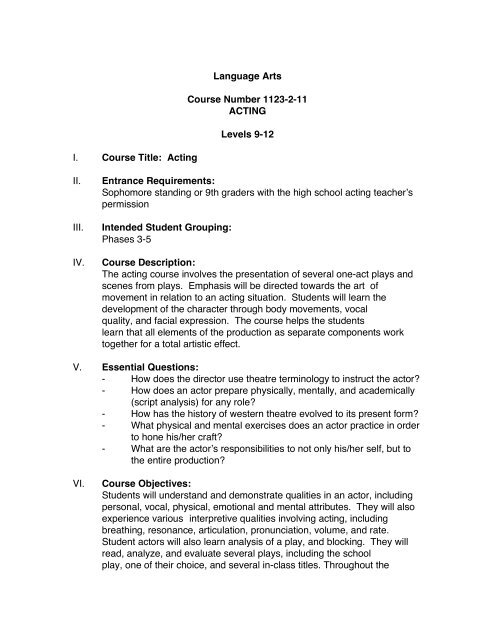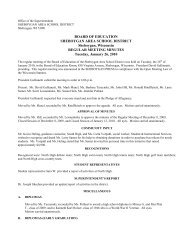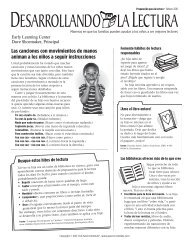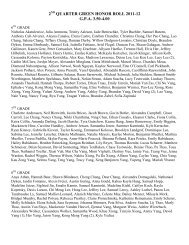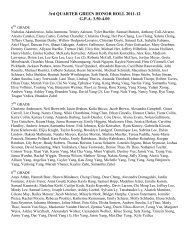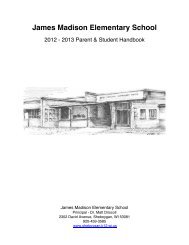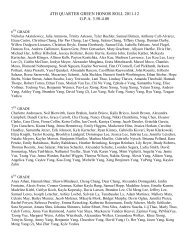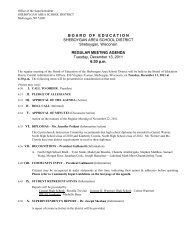Language Arts Course Number 1123-2-11 ACTING Levels 9-12 I ...
Language Arts Course Number 1123-2-11 ACTING Levels 9-12 I ...
Language Arts Course Number 1123-2-11 ACTING Levels 9-12 I ...
Create successful ePaper yourself
Turn your PDF publications into a flip-book with our unique Google optimized e-Paper software.
I. <strong>Course</strong> Title: Acting<br />
<strong>Language</strong> <strong>Arts</strong><br />
<strong>Course</strong> <strong>Number</strong> <strong><strong>11</strong>23</strong>-2-<strong>11</strong><br />
<strong>ACTING</strong><br />
<strong>Levels</strong> 9-<strong>12</strong><br />
II. Entrance Requirements:<br />
Sophomore standing or 9th graders with the high school acting teacher’s<br />
permission<br />
III. Intended Student Grouping:<br />
Phases 3-5<br />
IV. <strong>Course</strong> Description:<br />
The acting course involves the presentation of several one-act plays and<br />
scenes from plays. Emphasis will be directed towards the art of<br />
movement in relation to an acting situation. Students will learn the<br />
development of the character through body movements, vocal<br />
quality, and facial expression. The course helps the students<br />
learn that all elements of the production as separate components work<br />
together for a total artistic effect.<br />
V. Essential Questions:<br />
- How does the director use theatre terminology to instruct the actor?<br />
- How does an actor prepare physically, mentally, and academically<br />
(script analysis) for any role?<br />
- How has the history of western theatre evolved to its present form?<br />
- What physical and mental exercises does an actor practice in order<br />
to hone his/her craft?<br />
- What are the actor’s responsibilities to not only his/her self, but to<br />
the entire production?<br />
VI. <strong>Course</strong> Objectives:<br />
Students will understand and demonstrate qualities in an actor, including<br />
personal, vocal, physical, emotional and mental attributes. They will also<br />
experience various interpretive qualities involving acting, including<br />
breathing, resonance, articulation, pronunciation, volume, and rate.<br />
Student actors will also learn analysis of a play, and blocking. They will<br />
read, analyze, and evaluate several plays, including the school<br />
play, one of their choice, and several in-class titles. Throughout the
semester, students will perform satisfactorily various acting assignments,<br />
including the final performance. Lastly, they will also listen to and evaluate<br />
peer performances as well as other live performances attended for written<br />
critiques.<br />
VII. Standards and Benchmarks addressed in this course<br />
Students will:<br />
A. <strong>12</strong>.1 Use effective reading strategies to achieve their purposes in<br />
reading<br />
- Explain and evaluate the influence of format on the<br />
readability and meaning of a text “POETRY/DRAMA”<br />
A. <strong>12</strong>.2 Read, interpret, and critically analyze literature<br />
- Develop, explain, and defend interpretations of complex<br />
literary works<br />
- Explain how details of language, setting, plot, character,<br />
conflict, point of view, and voice in a work of literature<br />
combine to produce a dominant tone, effect, or theme<br />
- Develop and apply criteria to evaluate the literary merit of<br />
unfamiliar works<br />
A.<strong>12</strong>.3 Read and discuss literary and nonliterary texts in order to<br />
understand human experience<br />
B.<strong>12</strong>.1 Create or produce writing to communicate with different<br />
audiences, or a variety of purposes.<br />
- Compose and publish analytic and reflective writing that<br />
conveys knowledge, experience, insights, and opinions to an<br />
intended audience<br />
- Use rhetorical structures that divide complex thoughts into<br />
simpler ones, logical transitions from one thought to another,<br />
and language appropriate to the intended audience.<br />
- Write a creative fiction that includes an authentic setting,<br />
discernible tone, coherent plot, distinct characters, effective<br />
detail, believable dialogue, and reasonable resolution of<br />
conflict.<br />
- Write summaries of complex information (such as<br />
information in a lengthy text or a sequence of events),<br />
expand or reduce the summaries by adding or deleting<br />
detail, and integrate appropriately summarized information<br />
into reviews, reports, or essays, with correct citations.
B.<strong>12</strong>.2 Plan, revise, edit, and publish clear and effective writing<br />
- Write essays demonstrating the capacity to communicate<br />
knowledge, opinions, and insights to an intended audience<br />
through a clear thesis and effective organization of<br />
supporting ideas<br />
- Develop a composition through a series of drafts, using a<br />
revision strategy based on purpose and audience, personal<br />
style, self-awareness of strengths and weaknesses as a<br />
writer, feedback from peers regarding their written work<br />
C <strong>12</strong>.1 Prepare and deliver formal oral presentations appropriate to<br />
specific purposes and audiences.<br />
- Develop and deliver a speech that conveys information and<br />
ideas in logical fashion for a selected audience, using<br />
language that clarifies and reinforces meaning.<br />
- Demonstrates confidence and poise during presentations.<br />
Interacting effectively with the audience, and selecting<br />
language and gestures mindful of their effect.<br />
- Speak fluently with varied inflection and effective eye<br />
contact, enunciating clearly at appropriate rate and volume.<br />
C<strong>12</strong>.2 Listen to, discuss, and comprehend oral communications.<br />
- Evaluate a speaker’s use of diction, tone, syntax, rhetorical<br />
structure, and conventions of language considering the<br />
purpose and context of the communication.<br />
C<strong>12</strong>.3 Participate effectively in discussion.<br />
- Convey criticism in a respectful and supportive way.<br />
D.<strong>12</strong>.2 Recognize and interpret various uses and adaptations of<br />
language in social, cultural, regional, and professional situations, and learn<br />
to be flexible and responsive in their use of English.<br />
- Draw inferences about values, attitudes, and points of view<br />
by analyzing a writer’s or speaker’s use of English.<br />
VIII. Materials, Including Text<br />
- Exploring Theatre by Nancy Price and Heannie Jackson<br />
West Publishing Company, 1997, 2000,<br />
- Acting is Believing: A Basic Method/ 5 th edition by Charles<br />
McGraw and Larry D. Clark. Holt, Rinehart and Winston, incl.<br />
1987 (supplemental)<br />
- Theater: Preparation and Performance by Charlotte Lee and<br />
David Grott, Scott, Foresman and Company, 1982
- Various scripts/plays for student analysis – individual<br />
teachers’ discretion<br />
IX. Units addressed in this course:<br />
A. Getting Started in Theatre<br />
1. Developing Personal Resources<br />
2. Creative Drama<br />
B. Building Acting Skills<br />
1. Developing Voice<br />
2. Improvisation<br />
3. Characterization<br />
4. The Play and the Part<br />
5. Taking the Stage<br />
C. Producing and Appreciating Plays<br />
1. The Production Process<br />
2. Behind the Scenes<br />
3. Theatre Appreciation<br />
4. Your Future in Theatre<br />
D. Special Topics in Theatre<br />
1. Mime, Pantomime and Clowning<br />
2. Interpreting Literature<br />
3. Storytelling<br />
4. Readers Theatre and Radio Theatre<br />
5. Puppetry, Shadow Play and Masks<br />
E. Performance<br />
1. Class Exercises<br />
2. Various Scenes<br />
3. Final Performance<br />
X. Sample Class Activities<br />
A. Reading Activities<br />
1. Silent reading of textbook, exercises, scenes, and plays<br />
2. Oral reading of textbook, exercises, scenes, and plays<br />
B. Writing Activities<br />
1. Journal Writing<br />
2. Play Critiques/Reviews<br />
3. Creating Student Scenes/Plays<br />
C. Oral Activities<br />
1. Classroom discussion<br />
2. Peer Assessment of Activities<br />
3. Various Theatrical Performances
XI. Sample Assessments:<br />
A. Journal Rubric Assessment<br />
B. Six-Trait Writing Rubric Assessment for Essays<br />
C. Tests<br />
D. Quizzes<br />
E. Participation<br />
F. Question Checks<br />
G. Participation/Performances


